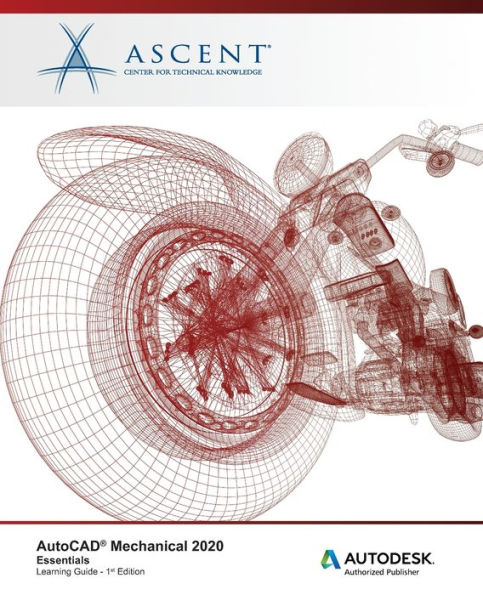Home
AutoCAD Mechanical 2020: Essentials: Autodesk Authorized Publisher
Loading Inventory...
Barnes and Noble
AutoCAD Mechanical 2020: Essentials: Autodesk Authorized Publisher
Current price: $111.00


Barnes and Noble
AutoCAD Mechanical 2020: Essentials: Autodesk Authorized Publisher
Current price: $111.00
Loading Inventory...
Size: OS
*Product Information may vary - to confirm product availability, pricing, and additional information please contact Barnes and Noble
The
AutoCAD
(R)
Mechanical 2020: Essentials
learning guide teaches students about the indispensable core topics required to use the AutoCAD
Mechanical software. Through a hands-on, practice-intensive curriculum, students acquire the knowledge needed to accelerate the mechanical design process. With specific tools for creating and manipulating geometry, automatically acquiring bills of materials, generating mechanical components, and performing design calculations, the AutoCAD Mechanical software offers significant productivity gains that the student learns to maximize.
Topics Covered
Identify the main interface elements, their setup and what Help information is available, and to create and use drawing template files.
Describe the object property management system in which layers are configured and the tools for manipulating layers.
Describe the workflows for organizing drawing geometry and create a Mechanical structure in a drawing by creating components, component views, and folders.
Describe the core mechanical design tools of rectangle, hatch, fillet, chamfer, holes, slots, and threads and how to use them to create and modify geometry in your drawings.
Modify and edit drawing objects by creating multiple offset copies, scaling them with separate values for the X and Y direction, or using a power command.
Insert industry standard parts into your assembly designs.
Create production-ready drawings in model space and layouts of structured and non-structured geometry and insert title blocks and borders.
Notate a drawing through the creation and editing of dimensions, hole charts, fits lists, and mechanical symbols.
Explain how to create and edit a bill of materials, parts list, and balloons.
Describe the tools that you can use to verify whether or not the standard parts or custom parts within your design meet or exceed the requirements for operational use.
Exchange data between CAD systems in the form of Mechanical DWG(TM) and IGES files and create Mechanical drawings using Inventor Link.
Create a custom drafting standard and drawing template that includes the configuration settings for layers, object properties, symbols, text, BOMs, parts list, balloons, and other annotation tools.
Prerequisites
This guide is designed for users who are new to the AutoCAD
Mechanical 2020 software.
A basic understanding of mechanical drafting or design.
A working knowledge of the AutoCAD
software.
A working knowledge of the Microsoft
Windows
10 operating system.
AutoCAD
(R)
Mechanical 2020: Essentials
learning guide teaches students about the indispensable core topics required to use the AutoCAD
Mechanical software. Through a hands-on, practice-intensive curriculum, students acquire the knowledge needed to accelerate the mechanical design process. With specific tools for creating and manipulating geometry, automatically acquiring bills of materials, generating mechanical components, and performing design calculations, the AutoCAD Mechanical software offers significant productivity gains that the student learns to maximize.
Topics Covered
Identify the main interface elements, their setup and what Help information is available, and to create and use drawing template files.
Describe the object property management system in which layers are configured and the tools for manipulating layers.
Describe the workflows for organizing drawing geometry and create a Mechanical structure in a drawing by creating components, component views, and folders.
Describe the core mechanical design tools of rectangle, hatch, fillet, chamfer, holes, slots, and threads and how to use them to create and modify geometry in your drawings.
Modify and edit drawing objects by creating multiple offset copies, scaling them with separate values for the X and Y direction, or using a power command.
Insert industry standard parts into your assembly designs.
Create production-ready drawings in model space and layouts of structured and non-structured geometry and insert title blocks and borders.
Notate a drawing through the creation and editing of dimensions, hole charts, fits lists, and mechanical symbols.
Explain how to create and edit a bill of materials, parts list, and balloons.
Describe the tools that you can use to verify whether or not the standard parts or custom parts within your design meet or exceed the requirements for operational use.
Exchange data between CAD systems in the form of Mechanical DWG(TM) and IGES files and create Mechanical drawings using Inventor Link.
Create a custom drafting standard and drawing template that includes the configuration settings for layers, object properties, symbols, text, BOMs, parts list, balloons, and other annotation tools.
Prerequisites
This guide is designed for users who are new to the AutoCAD
Mechanical 2020 software.
A basic understanding of mechanical drafting or design.
A working knowledge of the AutoCAD
software.
A working knowledge of the Microsoft
Windows
10 operating system.










